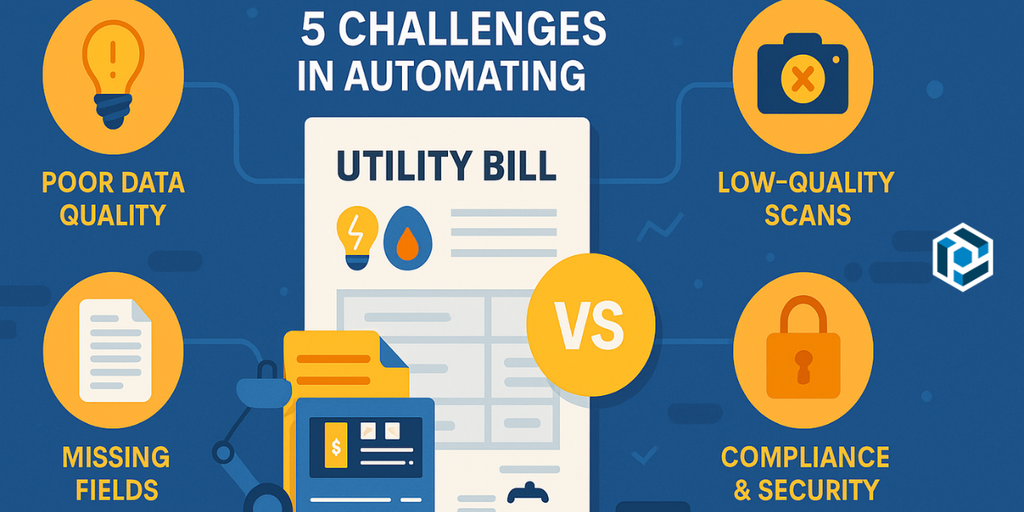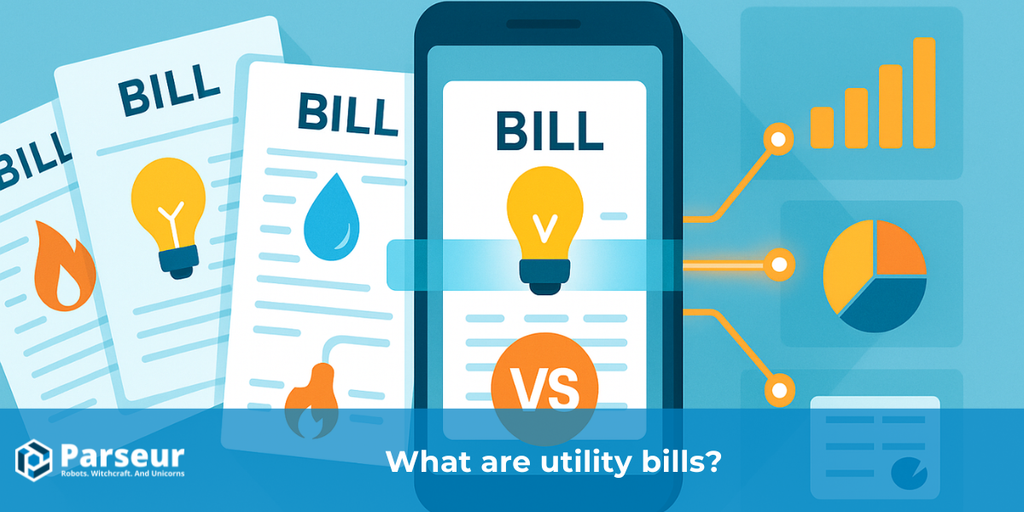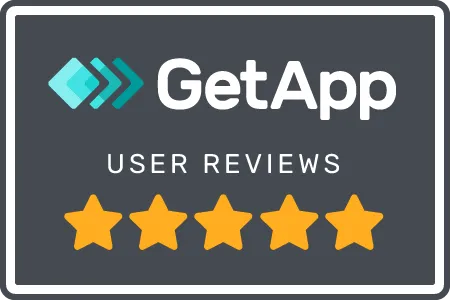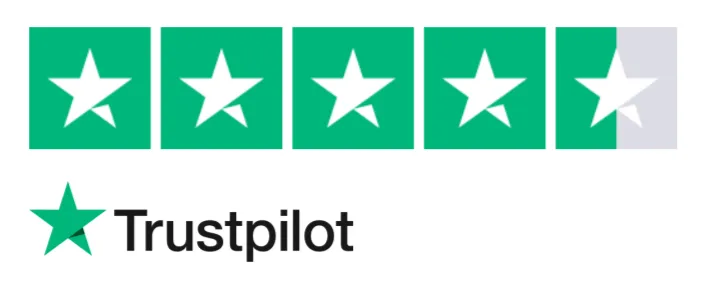How to extract data from utility bills?
You can extract data from utility bills by using Parseur's powerful AI engine.
Key takeaways:
- Manual bill processing is slow, costly, and error-prone.
- AI extraction cuts time by 80% with higher accuracy.
- Parseur automates extraction without templates or training, saving time and money.
Utility bills are a constant in personal and business life; electricity, water, gas, internet, and telecom invoices arrive every month without fail. Managing hundreds or thousands of bills for enterprises is more than just an accounting task; it’s a data challenge.
Manually entering bill details into spreadsheets or systems is slow, error-prone, and costly. According to Deloitte, companies lose millions annually to inefficiencies tied to manual billing processes.
What Is Utility Bill Extraction?
Utility bill extraction is automatically identifying and capturing important data fields, such as account numbers, customer details, consumption units, meter readings, charges, and taxes from utility bills. Instead of relying on manual data entry, this process uses technologies like Optical Character Recognition (OCR), Natural Language Processing (NLP), and Artificial Intelligence (AI) to convert unstructured documents into clean, structured data.
Most utility bills arrive as PDFs, scanned images, or emails, often with inconsistent layouts that make manual entry tedious. Extraction tools like Parseur simplify this by recognizing and standardizing key information, regardless of format. By using AI-powered data extraction, businesses can automatically capture and process billing data at scale, saving time, reducing costs, and ensuring accuracy.
For an individual, this document seems straightforward: pay what you owe. However, for enterprises, things get complex. A company might handle hundreds or thousands of monthly utility bills across multiple offices, departments, or client accounts.
This volume introduces challenges like:
- Data overload: analyzing usage trends across locations.
- Error-prone manual entry: retyping figures into spreadsheets or accounting systems.
- Compliance risks: needing accurate billing data for audits or ESG reporting.
Benchmarks & Statistics
Processing utility bills manually remains surprisingly costly and slow, and the numbers show why automation matters.
- Average manual processing time: According to Resolve, hands-on data entry for a single bill typically ranges from ~8-12 minutes (data-entry portion), depending on complexity; broader invoice workflows can be much longer.
- Manual entry cost per bill (processing and approval): Based on ERP, direct data-entry labor is commonly estimated at $1–$3 per document for simple entry tasks; full manual invoice processing (with approvals, matching, exceptions) can be substantially higher.
- Error rates: Human data-entry error rates vary with task complexity but commonly fall in the 1–5% range for structured entries, higher for complex or multi-field documents. Even a few percent error on billing data quickly creates costly reconciliation and compliance work, according to Fluxygen.
- Automation impact (speed & cost): AI and IDP can dramatically reduce processing time with real improvements reporting reductions from minutes (or days for full workflows) down to seconds or a few minutes per document and substantial per-document cost savings. Case studies and vendor benchmarks show up to ~80% time savings against manual methods in many invoice/bill workflows, as stated by Ramp.
- Vendor benchmarks: Gartner reports 90–99% extraction accuracy for document parsing (depending on document quality and whether human validation is applied). These real-world figures illustrate how utility-bill automation translates into lower error rates, faster processing, and cost reduction.
Why does the utility bill extract matter?
Utility bills are like those monthly visitors that demand attention to detail. From electricity to water, these extracts reveal the financial chapters of your business life. In many countries, utility bills are used as proof of residence and companies need to parse those bills from their customers to check whether the address they entered when signing up match the one on the bill.
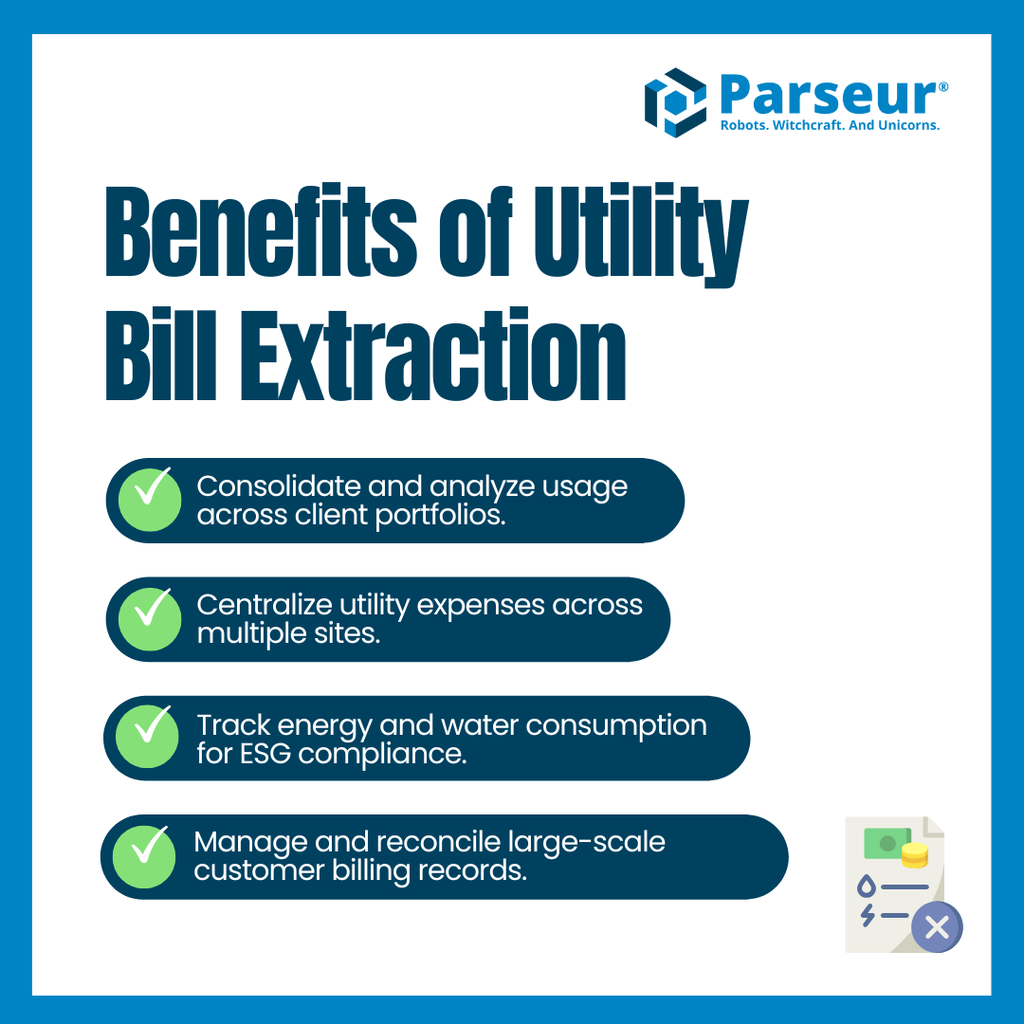
Ultimately, understanding utility bill extracts is your path to financial empowerment. It's not just about paying bills; it's about controlling your money, making informed decisions, and building a stronger financial future.
Use Cases & Benefits
- Energy Management Firms → Consolidate and analyze usage across client portfolios.
- Enterprises → Centralize utility expenses across multiple sites.
- Sustainability Reporting → Track energy and water consumption for ESG compliance.
- Telecom/ISPs → Manage and reconcile large-scale customer billing records.
Have you ever noticed a sudden spike in your utility bill?
Understanding the extracts acts like a financial radar, alerting you to unusual trends. It's not just a bill; it's your early warning system for potential budget storms.
Ultimately, understanding utility bill extracts is your path to financial empowerment. It's not just about paying bills; it's about controlling your money, making informed decisions, and building a stronger financial future.
Challenges in Utility Bill Extraction
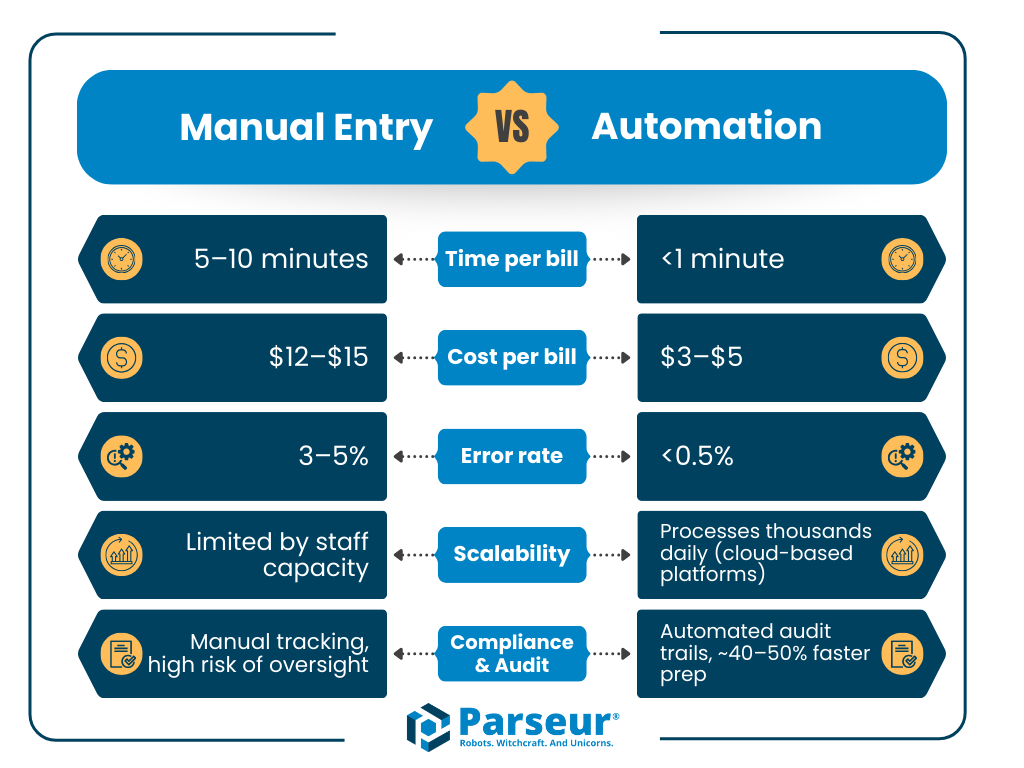
- Data variability → Providers use different formats, making standardization difficult.
- Unstructured PDFs & scans → Many bills arrive as images or poorly scanned documents, requiring advanced OCR.
- Compliance & audits → Utility bills often serve as proof of address or records for tax and ESG audits, demanding accuracy.
- Volume & scalability → Enterprises may process thousands of monthly bills, making manual entry unfeasible.
Understanding utility bill extraction is complex and requires AI
Utility bill extracts are simply extracted or parsed data from those documents. When you receive a utility bill, the data is usually in unstructured form, which is challenging to process and analyze.
Automated data extraction from utility bills with AI
AI has integrated into every industry for the past few years and made everyone's life easier. The key is to choose the right AI tool that fits your specific needs and, one such AI solution is Parseur.
How does Parseur help with utility bill extraction?
Parseur is an AI-powered document processing platform designed for utility bill extraction at scale.
- Template-free: Works with any utility bill layout; no manual setup is needed.
- Integrations: Connects seamlessly with Excel, ERPs, and CRMs.
- Efficiency: Processes hundreds or thousands of bills daily.
- Secure: GDPR, ensuring sensitive billing data is handled safely.
Parseur bridges the gap between messy utility bills and structured data, giving businesses control, efficiency, and compliance.
How does Parseur help with utility bill extraction?
If you’re new to Parseur, consider it a reliable partner for managing utility bills. Rather than spending hours handling PDFs, scans, or spreadsheets, Parseur’s AI engine automates the extraction process, turning unstructured documents into clean, ready-to-use data. With built-in integrations to tools like Excel, Google Sheets, and major accounting or ERP platforms, Parseur doesn’t just extract data; it makes it practical. Whether you need utility bill information for budgeting, compliance, or sustainability reporting, the platform ensures your data flows seamlessly into the systems you already use.
Parseur automates data extraction from utility bills automatically with its powerful AI engine. It converts unstructured data into structured data that can be used easily for further analysis.
Do I need to train the AI model?
Calm down; we don't do that here.
Parseur is an easy-to-use AI parser where you don't need to spend hours training the AI model. It can understand you without a word.
Once you've created a utility bill mailbox, just upload the utility bill, sit back and relax. Parseur knows what it's doing; the AI engine has been trained to make your work week easier.
What fields does Parseur extract from utility bills?
Parseur can extract the following information:
- Account number
- GST number
- Statement number
- Customer details (name, address, phone number)
- Usage (unit count, unit price)
- Utility company
- Tax amount
- Total amount
Utility bill extraction is done
You also have the option to list specific fields that you need and teach Parseur how to become your assistant.
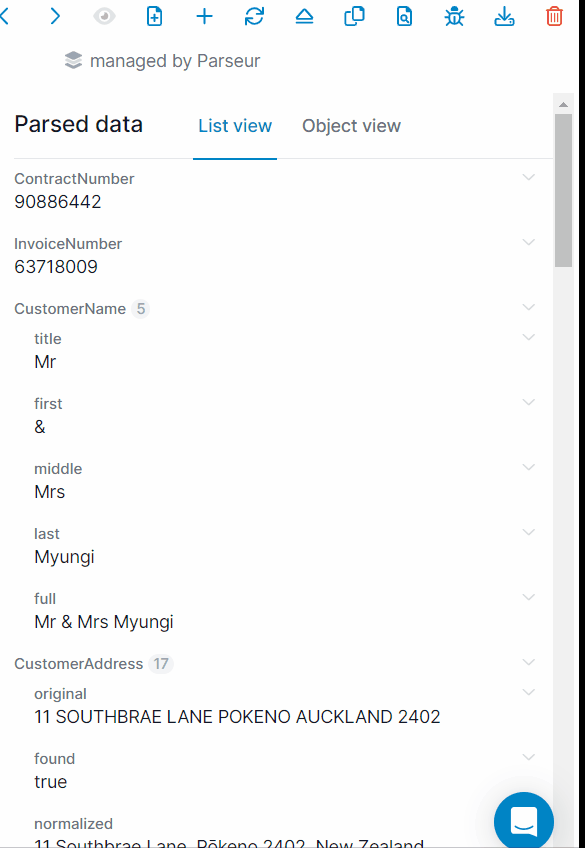
What if I need to send the data to another application?
Use Parseur's native integrations with Zapier, Make, or Webhook. We have a solution for everyone.
Read more about the steps to extract data from utility bills with AI
Is Parseur free?
If I'm being honest, there is no such thing as a free lunch. But, since we have a big heart, you can try the AI engine on our free plan.
Want to check how much time (and money) you can save with Parseur?
Frequently Asked Questions
Managing utility bills can be tricky, especially when dealing with hundreds or thousands every month. We've compiled the most common questions and answers below to help you understand how AI-powered utility bill extraction works and how Parseur makes it simple, accurate, and secure.
-
What is utility bill extraction?
-
Utility bill extraction automatically captures key details (such as account numbers, usage, taxes, and charges) from utility bills using OCR and AI instead of manually entering them.
-
How does OCR extract data from utility bills?
-
OCR (Optical Character Recognition) converts scanned utility bills or PDFs into machine-readable text, which AI then structures into fields like consumption, customer info, and charges.
-
Can I export utility bill data to Excel?
-
Yes. Most automation platforms, including Parseur, allow you to export extracted data into Excel or Google Sheets, or connect it with accounting, ERP, and BI tools via integrations or APIs.
-
Is utility bill data secure when processed with AI tools?
-
Security is a priority. Tools like Parseur are GDPR-compliant and designed to process sensitive billing data safely, ensuring records remain audit-ready.
-
What types of utility bills can be extracted?
-
Parseur works with electricity, water, gas, telecom/phone, and internet bills, so no templates or manual setup is required.
-
Do I need to train Parseur before using it?
-
No. Parseur is template-free and pre-trained to handle different layouts instantly. You can start extracting data from day one without training sessions.
-
How accurate is AI-based utility bill extraction?
-
Benchmarks show 90–99% accuracy in real-world utility bill extraction, especially when paired with light human validation for edge cases.
Last updated on

